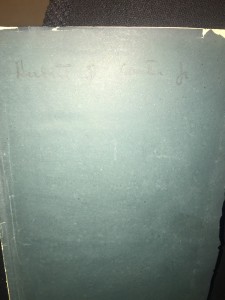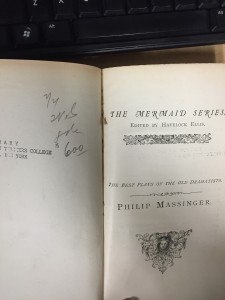I want to start off by saying that Sojourner truth library is extremely intimidating. This was my first time searching for books at a college library. It was very tedious searching for a 19th century book that also had 19th century marginalia. After over an hour of picking the books that looked most worn out (this was my strategy) I finally hit the jackpot when I picked up “Phillip Massinger” edited with an introduction and notes by Arthur Symons. The title alone was very confusing because Phillip Massinger is the main author and it contains “the best plays of the old dramatists.”
http://www.booktraces.org/book-submission-philip-massinger
However, after reading through the book it was made clear that Phillip Massinger was the author of numerous plays that constituted the book and Arthur Symons provided readers with a bibliography of Phillip Massinger and spoke about his plays.

“Phillip Massinger” was published in London in 1887 and its publisher is London Vizetelly.
As soon as you open the book,on the inner hardcover there is a name that reads: Hailey S. Carles Jr. and is barely visible but after 5 minutes of analyzing each letter with a flashlight I was able to make out the name.
After searching all over the internet I was not able to trace this name to any person. This was probably because it was just an average person in London, who owned this book and wrote their name to show possession.
The book itself is very old and smells like it as soon as you open it. By this I mean it literally smells “dusty” and made me sneeze as I flipped through the pages.
The other marginalia that I found (on the first 2 pages after opening the book) was for the most part illegible and I was unable to understand its purpose.
There is however, the number 600 clearly written which could indicate what is equivalent to 900 dollars ( a lot of money back then).
What I found most interesting were the way some pages were set up (shut together) making the pages in the middle of that binding hard to read.
From pages 9 to 96 there are 11 “sections” where the binding is like this, making it hard to read what is in between them.
This seems to have been done purposefully but I am not sure for what reason or if this is a characteristic of 19th century books but it was very interesting and different.
Overall I enjoyed learning about marginalia and having the chance to actually find a 19th century book with personal hand writing from the 19th century. Book traces and preserving this marginalia is important to understanding how people used books in the 19th century.



